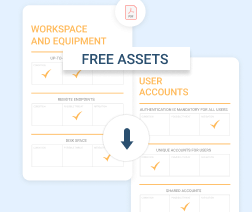The average cybersecurity budget is expected to increase 71 percent over the next three years, quickly approaching $1 trillion globally spent on a variety of technology solutions to protect businesses around the world.
However, businesses also need to consider that sometimes the most impactful thing they can do is implement a regular maintenance routine. When it comes to maintaining a smoothly operating network and preventing a malicious cyberattack, getting the routine basics right is key.
For instance, an estimated average of 1 in 3 breaches is caused by unpatched vulnerabilities, which are known flaws in software or hardware that the business, for whatever reason, fails to fix before attackers leverage it to breach their environment. This is just one example of a routine maintenance item that could make a significant difference to an organization’s cybersecurity posture.
Routine maintenance can also help ensure that the overall network is healthy and works smoothly by optimizing operations and identifying potential problems, such as a device that is approaching its end of life or a poorly configured network segment, before they become a catastrophic issue. Addressing these potential problems sooner rather than later helps a business avoid downtime and prevent data loss.
However, ongoing, proactive routine maintenance can be easier said than done for many small and medium, or even large, businesses. It requires ongoing attention to the latest issues and threats, dedicated staff to perform the maintenance, and regular commitment of budget to correct any issues. MSPs can play a key role in helping businesses of every size ensure that they know what routine maintenance they need to perform, and then helping them to act on those needs.
Maintaining Healthy Systems — What Does It Take?
The routine maintenance checklist will be different for every business, based on their size, industry, and technology needs. Part of an MSP’s role is helping a client identify what routine maintenance they need and then building a plan together to ensure that those items are taken care of on a regular basis, leveraging the MSP’s services, technicians, and other staff.
There are a number of areas to consider when it comes to building a routine maintenance plan. IT asset discovery and inventory should be part of this process to ensure there is an up-to-date understanding of what devices are inside the environment. It should also include testing of backup and disaster recovery systems to ensure that they are working correctly in case of a server failure or ransomware attack.
Further reading Backup and Disaster Recovery Explained
There are a number of things a business can do to ensure that routine maintenance results in better security protection and lower overall risk of a cyberattack. Routine maintenance can include ensuring that critical software, such as antivirus and anti-malware, is fully updated and running correctly. It can also include scheduled scans and deployment of security patches to remediate software vulnerabilities. The gold standard for implementing a security patch is 30 days, but it typically takes a business 60 to 90 days, or longer. Without a routine maintenance plan to help implement these patches, a business is putting itself at risk of attack.
Assess vulnerabilities and threats, network security, workspace and equipment security, documentation, and more. The pack includes:
- a ready-to-print PDF file
- an Excel file to help create a customizable assessment resource
Finally, some organizations may have additional routine maintenance requirements in order to remain compliant with important industry regulations, such as GDPR, PCI, or HIPAA. An MSP can put in place the checks and balances to ensure that these business requirements are met across every area of the business on an ongoing basis.
Identifying Potential Problems (and How to Fix Them)
The process of identifying routine maintenance needs begins with a thorough evaluation of a client’s network, including asset inventory, current patch management practices, age of systems, current software versions, backup and recovery status, and more. There should be a thorough discussion of a client’s overall priorities in terms of their technology infrastructure and needs, as this will also help define resource allocation and overall requirements.
Further reading Network Audit Guide
An MSP should craft a plan in partnership with the client to conduct this routine maintenance plan on a continuing basis. This includes a roadmap for regular, ongoing scans and maintenance, as well as larger projects that may need to be undertaken in order to upgrade systems or replace aging infrastructure. These routine maintenance items should be carefully aligned with the client’s strategic priorities and needs.
While the goal is to limit disruptions to the client’s business, some routine maintenance may require scheduled downtime in order to carry it out. This may include updating network drivers, adding rules or features to the firewall, updating a critical business application, or making changes to the Exchange Server configuration (though these items will depend on the state of the client’s systems or their overall needs). This should be performed with clear communication with the client’s employees about when downtime will occur, communication with client management or IT teams about what updates will be taking place and how long they will take, and documentation of the maintenance tasks carried out.
More Maintenance, Less Overall Potential Cost
The goal in implementing routine maintenance is to eliminate unexpected catastrophic events by identifying potential issues before they become a problem. In doing this, an MSP can help to ensure that its clients’ systems run more smoothly and more securely, and perhaps even have a longer lifespan.
A side benefit of this is potentially lower costs, both for the MSP and the client. Maintaining systems increases the probability that they will last longer, instead of failing before their expected lifespan is up. On top of that, a catastrophic event is significantly more costly for a client, not only causing downtime that may affect the business’s ability to operate and make money, but also requiring emergency service hours and possibly last-minute installation of equipment in order to remedy the situation. Instead, they can leverage an MSP for regular routine maintenance services at a fixed monthly rate.
Routine maintenance also benefits the MSP’s business model. Recommending ongoing services and support helps an MSP retain customer loyalty, as well as potentially increasing revenue as new needs emerge or the client’s business grows. It also puts them on the front line for new project business when a client needs a major upgrade, perhaps to its infrastructure, or to add a new office as their company grows.
Similarly to running a car, it helps to be proactive when it comes to routine maintenance for a business’s technology stack (instead of oil changes, this involves ensuring that systems are patched, networks are regularly monitored, and other critical services). An MSP is the perfect partner for a business to work with in order to make sure that its routine maintenance needs are met and its technology is set to run like a well-oiled machine for many years to come.

About the author
Alexander is the head of marketing department at MSP360. He is an expert in IT marketing and has extensive knowledge of cloud storage services. Alexander cooperates with cloud vendors, MSPs, VARs and communicates the market needs and trends to our team.
More articles by Alexander






